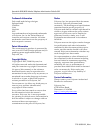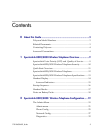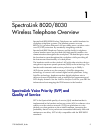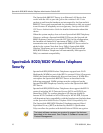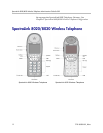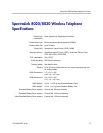
SpectraLink 8020/8030 Wireless Telephone: Administration Guide for SRP
10 1725-36030-001_B.doc
The SpectraLink 8000 SVP Server is an Ethernet LAN device that
works with the APs to provide QoS on the wireless LAN. Voice
packets to and from the handsets are intercepted by the SpectraLink
8000 SVP Server and encapsulated for prioritization as they are routed
to and from an IP telephony server or gateway. See SpectraLink 8000
SVP Server: Administration Guide for detailed information about this
device.
When the system employs four or fewer SpectraLink 8000 Telephony
Gateways without a SpectraLink 8000 SVP Server, the SpectraLink
8000 Telephony Gateway(s) provide SVP QoS. In this configuration,
the handsets are limited to a maximum of 2Mb/s. If the 11Mb/s
transmission rate is desired, a SpectraLink 8000 SVP Server must be
added to the system. Note that if any 2Mb/s SpectraLink 8000
Wireless Telephones are in use (model PTB5xx) the SpectraLink
8020/8030 Wireless Telephones will automatically limit speed to
2Mb/s to maintain compatibility.
SpectraLink 8020/8030 Wireless Telephone
Security
SpectraLink 8020/8030 Wireless Telephones support basic Wi-Fi
Multimedia (WMM) as part of the 802.11e protocol. If the AP supports
WMM, the handset automatically discovers and uses it. WMM does
not replace the SpectraLink 8000 SVP Server as described in the
following paragraph. WMM settings must be configured on the
SpectraLink 8000 Telephony Gateway and on the SpectraLink 8000
SVP Server.
SpectraLink 8020/8030 Wireless Telephones also support the 802.11i
protocol including Wi-Fi Protected Access (WPA and WPA2) pre-
shared key (PSK). As vendors introduce APs that are eligible to
become Wi-Fi Certified for WPA-PSK and/or WPA2-PSK, Polycom
will determine their compatibility with the handsets and include them
on the SpectraLink 8000 Wireless Telephone WLAN Compatibility List.
The SpectraLink 8020/8030 Wireless Telephones support Wired
Equivalent Privacy (WEP) as defined by the 802.11 specification.
Polycom offers the product with both 40-bit and 128-bit encryption.
The latest software versions are required to support the features
described in this document. See Chapter 3 Software License and
Protocol Management.



